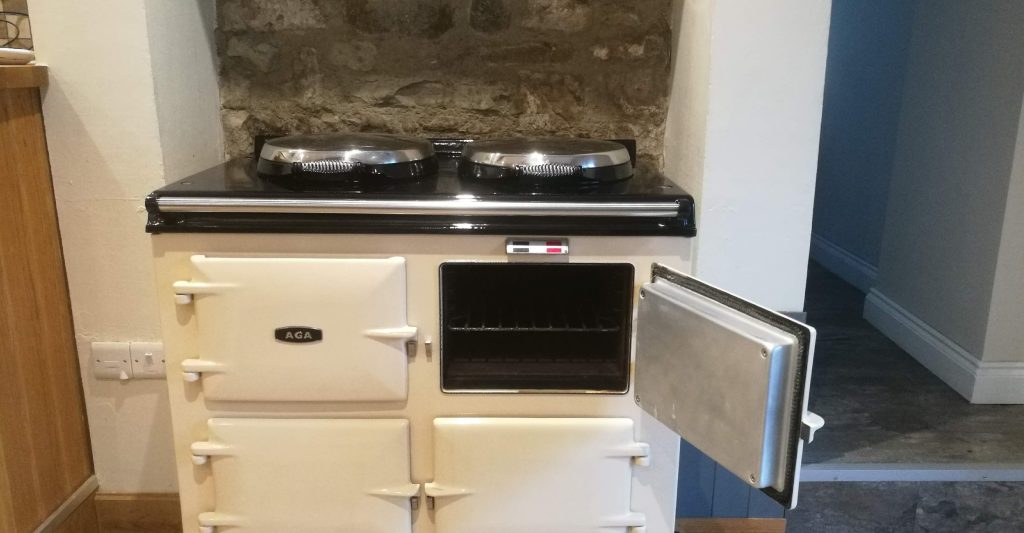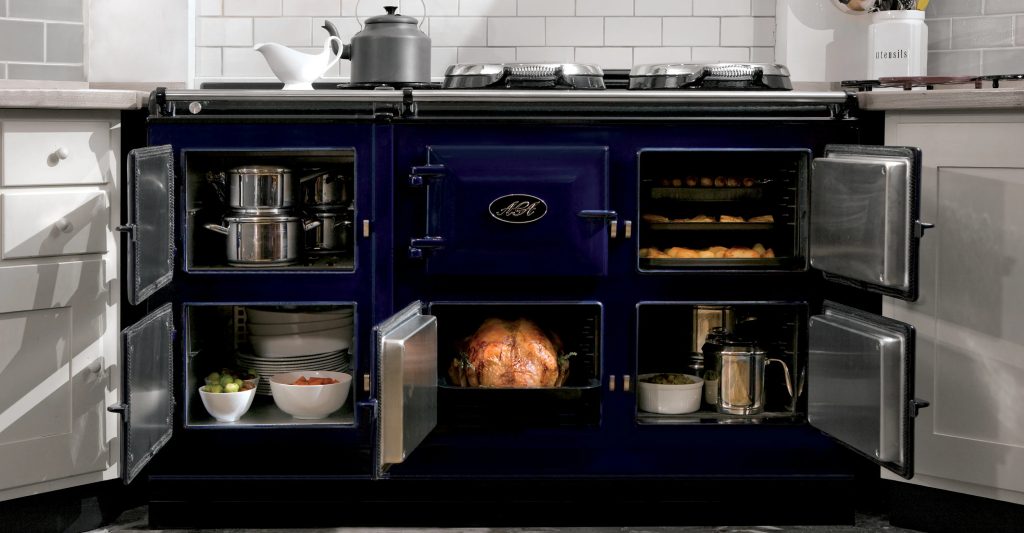Table of Contents
Aga and Rayburn heating cookers are cooking appliances that provide heart, warmth, and comfort to a home. There are numerous parallels between these two ranges, yet there are also clear distinctions. If you’re thinking about installing a range and want to figure out which one will work best for you, knowing these differences will be important for a central heating cooker.
An AGA range cooker is what?
AGA cookers are heat storage appliances. Since it is formed of cast iron, it effectively stores and conducts heat. Modern AGAs operate on gas, electricity, or oil even though they were initially intended to use multi fuels.
AGAs feature several hotplates and automated thermostat-controlled ovens that are designed to be constantly on. The chef may make many meals at once since the ovens are all set to various temperatures.
A Rayburn range cooker is what?
Rayburns are cast-iron heat storage ranges with the ability to heat water, much as AGAs. In the case of the larger versions, certain Rayburns may additionally operate up to 20 radiators.
Further to versions suited for use with wood, briquettes, or coal, Rayburns models may be purchased that operate on oil or gas, electricity.
What distinguishes an AGA from a Rayburn cooker?
One significant distinction is that a Rayburn may be used as a stove, hot water boiler, and central heating system all in one. A Rayburn could be better suited for your requirements if conserving space is a concern.
A Rayburn also provides a variety of solid fuel sources, which may be crucial if you reside in a rural area without access to gas or have frequent power outages.
Rayburn : Features at a Glance
- Semi-heat storage stove: Unlike the AGA constant heat output, Rayburn are designed for more flexible use—some models offer a choice between continuous or intermittent burning, making them adaptable to your heating and cooking schedule.
- Versatile functionality: Choose from models that handle cooking only, cooking plus hot water, or cooking, hot water, and central heating—all in one compact appliance.
- Oven options: The main top oven’s temperature can be adjusted to suit different dishes, while the smaller lower oven doubles as a warming space—handy when you’re juggling multiple courses.
- Hot plate: A single, rectangular hot plate provides graduated heat settings, allowing for anything from a rolling boil to a gentle simmer by simply shifting pans across the surface.
- Variety of sizes: Rayburn come in different sizes but tend to be smaller—and less expensive—than AGA , making them ideal for kitchens where space or budget is a concern.
So, if you’re looking for a hard-working, space-saving range that can do it all—cooking, heating water, and even running your radiators—the Rayburn might just tick all your boxes.
The primary distinction between Rayburn and AGA
Even though AGA stoves don’t have hot water or central heating, they have a much wider range of cooking options. Which of these benefits you get will depend on the models you choose. This is a more thorough explanation of these choices:

AGA
- A heat storage cooker with thermostat-controlled heat generation that is “always on.”
- You place the food in the oven that is appropriate for the meal being made since the various ovens have various preset temperatures.
- Two spherical hotplates, one for simmering and the other for boiling.
- Available in oil, electricity, and bottled or natural gas variants.
AGA 2-ovens
- an oven with a heated top for baking or roasting.
- a lower, cooler oven for simmering or slow cooking
- The size of the two ovens is comparable.
AGA 3-oven
- The roasting oven is hot and to the right.
- The bottom right corner of the oven is a moderate oven.
- For simmering and slow cooking, use the cooler bottom oven.
- The three ovens are about the same size.
AGA 4-oven
- Roasting oven on the top right side.
- bake in a moderate oven on the bottom right.
- top-left oven with a simmer.
- warming oven on the bottom left.
- The size of every oven is the same.
- a two-burner gas hotplate or a warming plate is available.
Rayburn
a stove for storing heat.
- Cooking just, cooking plus hot water, or cooking, hot water, and central heating are all options.
- Certain types let you choose between intermittent and continuous burning.
- a top primary oven with temperature control.
- a warming oven with a smaller, lower oven.
- There is one rectangular hot plate with graded heat settings.
- While there are several sizes available, Rayburns are usually smaller than AGAs (and less expensive).
- Also see How to Get Rid of a New Oven Smell.

Comparison of AGA with Rayburn
AGA and Rayburn have a few similarities, the majority of which contribute to their lasting appeal as options.
Cast iron building.
- With a variety of colours, vitreous enamel finish is available.
- As compared to traditional cookers, high initial cost.
- a long life span (if well-maintained an Aga or Rayburn can last for decades).
- friendly to the environment (cast iron cookers can be repaired and new ones may be constructed from recycled metal).
- Classic style (fashions come and go but an AGA or Rayburn range will never look dated or tired).
AGA and Rayburn range cookers vs traditional oven: pros and drawbacks
Still unsure as to whether an AGA or Rayburn is necessary, or whether a more traditional cooking equipment would be a better choice? Of course, each choice has advantages and disadvantages:

AGA and Rayburn’s benefits and drawbacks
Professionals in AGA and Rayburn With an AGA range, you can cook meals that require different temperatures at the same time. Both ranges will serve as cookers and a source of heat for your kitchen.
- If you choose a Rayburn, you can choose a model that also heats your water and runs your central heating. There are versions of Rayburn ranges that use solid fuel.
- Cooking using radiant heat is more uniform and seals in flavours without drying out the food.
Cons of AGA and Rayburn
Since AGAs are made to run all the time, you may need a second stove in the summer to keep your kitchen from getting too hot. For a beginner, cooking on a range might be tough, but once the skill is mastered, most people say they’d never go back.
- If you don’t cook often, a range can be more than you need.
- Due to their size, range cookers may not be ideal for a small kitchen.

Benefits and drawbacks of built-in and conventional ovens
Range cookers are seldom chosen by consumers. What are they losing out on, and why would that be the case?
Pros of both traditional and built-in ovens
- The size of the oven you purchase should fit your kitchen.
- Most recipes are based on cooking times in normal ovens, making them simpler for a beginner chef to handle.
- A contemporary, sleek kitchen may appear better with a built-in oven.
- Traditional cookers may be adjusted to any height, which reduces the need to crouch and bend.
- Modern add-ons like steam or microwave ovens are available with several traditional stoves.
- There are current technology features available, such touchscreen control or Wi-Fi.
- Easier to manage for those just starting out in the kitchen, with most instructions and techniques geared towards these types of ovens.
- Some conventional ovens now come with features like steam cooking, microwave integration, or smart controls, offering convenience and flexibility.
Cons of traditional and built-in ovens
Due to the limited cooking area, you can only make one or two items at a time. With a normal oven, it might be challenging to bake evenly.
If you want to use a range cooker for everything, you may need to purchase other equipment.
- Baking evenly can sometimes be a struggle in a conventional oven, especially when preparing multiple dishes.
- Limited internal space means you may be juggling oven racks or timing if you want to cook a feast.
- Extra appliances—like slow cookers, steamers, or even an additional oven—may be needed to match the versatility of a range.
So there you have it, a detailed explanation of the differences between Rayburn and AGA range cookers. There are a few things to keep in mind:
Larger kitchens are often a good fit for AGA or Rayburn stoves. AGA ranges are the most appealing to those who enjoy cooking and want to prepare multiple meals at once. While less adaptable than stoves, rayburns may provide hot water and central heating.
It’s also worth noting a few key points when making your decision:
- Kitchen Size Matters: Both AGA and Rayburn range cookers tend to suit spacious kitchens best, as their size and constant heat output can overwhelm a smaller space.
- Cooking Enthusiasts Benefit Most: AGA cookers shine for serious cooks who relish the ability to prepare several dishes at different temperatures simultaneously.
- Rayburn’s Added Functionality: Rayburn , while not as flexible for diverse cooking styles, excel as a multi-purpose appliance—offering not just cooking, but also the potential for hot water and central heating.
This makes them ideal if you’re looking for a range cooker that goes beyond the basics, especially in a home where heating and hot water integration are a priority.
It’s worth noting that these ranges are generally best suited for households that are serious about their cooking and have the space to accommodate them. If you’re considering a Rayburn , its unique ability to double as a source of hot water and home heating is a major advantage, though it means sacrificing some of the cooking flexibility you’d find with an AGA . Ultimately, choosing between an AGA and a Rayburn comes down to your kitchen size, how much you cook, and whether you also want your range to lend a hand with heating or hot water.




